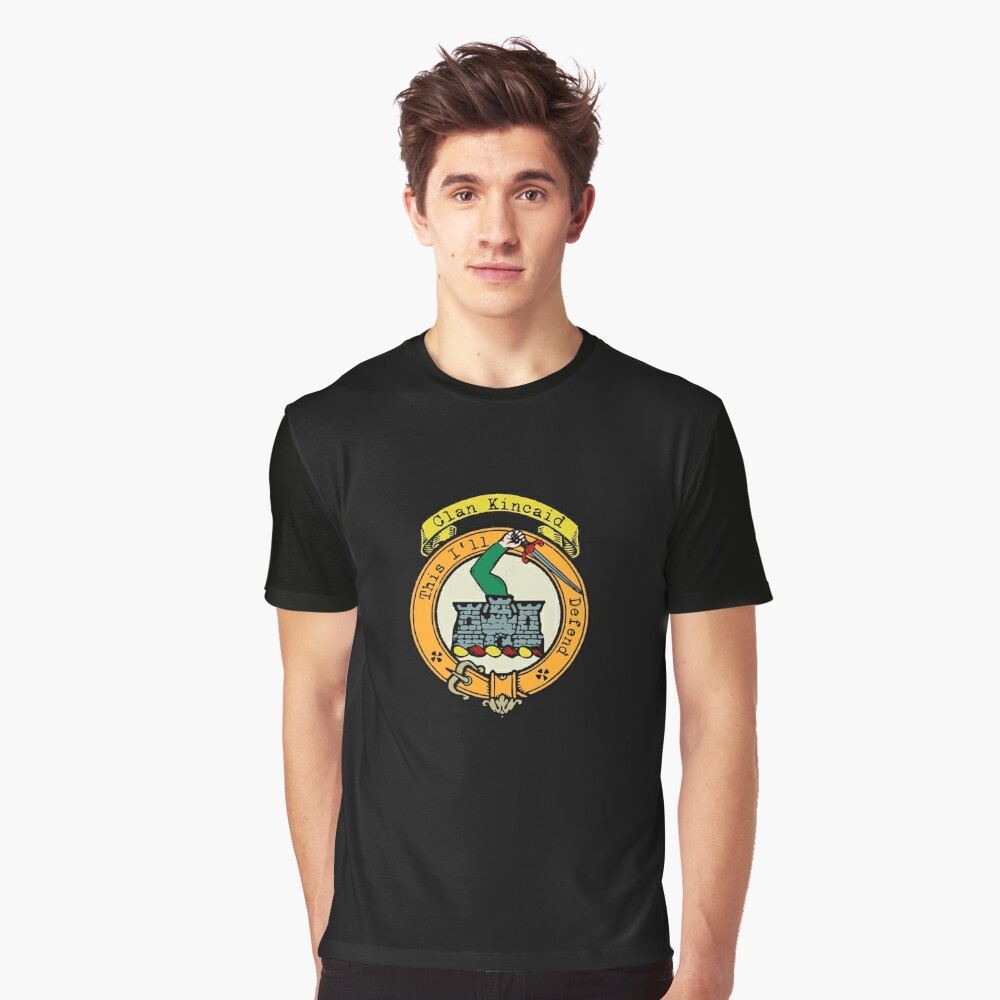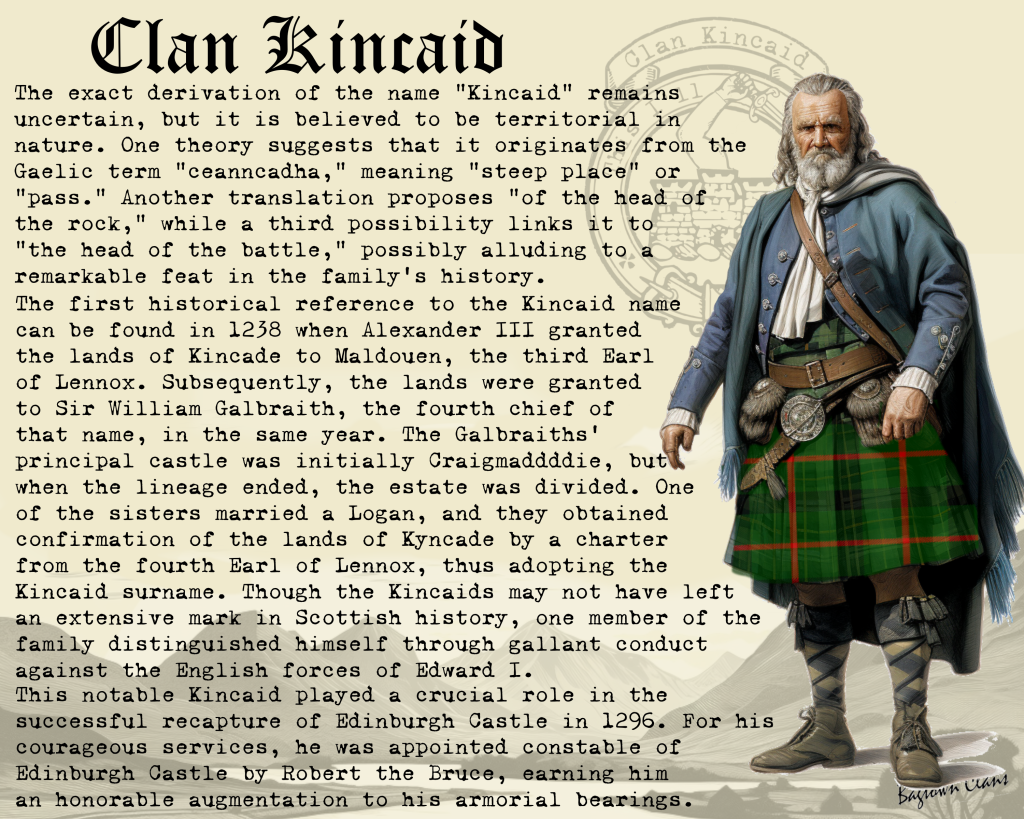Kincaid Clan Crest
|
|
CREST: A triple towered castle Argent, masoned Sable, and issuing from the center tower a dexter arm from the shoulder embowed, grasping a drawn sword all Proper MOTTO: This I’ll defend TRANSLATION: N/A VARIATIONS: N/A |
| Scotland is a land rich in history, legends, and noble clans. Among these prominent clans is the Kincaid clan, with a heritage rooted in ancient Scottish nobility. From their uncertain origins to their gallant feats in battle, the Kincaids have left an indelible mark on Scottish history. In this blog post, we delve into the fascinating story of the Kincaid clan, tracing their lineage, notable achievements, and enduring legacy.
The exact derivation of the name “Kincaid” remains uncertain, but it is believed to be territorial in nature. One theory suggests that it originates from the Gaelic term “ceanncadha,” meaning “steep place” or “pass.” Another translation proposes “of the head of the rock,” while a third possibility links it to “the head of the battle,” possibly alluding to a remarkable feat in the family’s history. |
|
 |
|
| Purchase @ Redbubble Purchase @ Amazon.com Purchase @ Amazon.co.uk |
|
| The first historical reference to the Kincaid name can be found in 1238 when Alexander III granted the lands of Kincade to Maldouen, the third Earl of Lennox. Subsequently, the lands were granted to Sir William Galbraith, the fourth chief of that name, in the same year. The Galbraiths’ principal castle was initially Craigmaddddie, but when the lineage ended, the estate was divided. One of the sisters married a Logan, and they obtained confirmation of the lands of Kyncade by a charter from the fourth Earl of Lennox, thus adopting the Kincaid surname. Though the Kincaids may not have left an extensive mark in Scottish history, one member of the family distinguished himself through gallant conduct against the English forces of Edward I. This notable Kincaid played a crucial role in the successful recapture of Edinburgh Castle in 1296. For his courageous services, he was appointed constable of Edinburgh Castle by Robert the Bruce, earning him an honorable augmentation to his armorial bearings—a reference to his remarkable feat. When the Kincaids acquired their lands in the late thirteenth century, they likely erected a tower or peel to fortify their holdings. While no trace of the original building remains today, a house was constructed around 1690, later enlarged in the mid-eighteenth century, and finally rebuilt in 1812. These architectural transformations serve as testaments to the Kincaids’ enduring presence and the importance of their ancestral seat. From the late sixteenth century onwards, the Kincaids expanded their landholdings in the east of Scotland. Through advantageous marriages, they acquired the estate of Craiglockhart near Edinburgh. Over time, the Kincaids added to their possessions with the estate of Bantaskin near Falkirk, the formidable Blackness Castle near Linlithgow, and the fields of Warriston, now a suburb of Edinburgh.
Like many noble families, the Kincaids were not immune to feuds and tragic events. In the 1570s, Malcolm Kincaid, who lost his left arm in a clan skirmish, engaged in a feud with the Lennoxes of Woodshed. Unfortunately, Malcolm was killed by a Stirling of Glovat in 1561. Interestingly, it was through marriage to the Lennox family that the Kincaid name was carried on, eventually leading to the clan’s reestablishment as an independent entity in the twentieth century. In the year 1600, John Kincaid of Warriston met a tragic fate. He was murdered by one of his grooms who conspired with his wife. The plot was uncovered, and the groom was forced to confess. Both the groom and the Lady of Warriston faced the ultimate penalty for their crime. While the Lady of Warriston, out of respect for her rank, was beheaded, the groom suffered a gruesome fate—being “broken on the wheel.” The Kincaids demonstrated unwavering loyalty to the royalist cause during the seventeenth-century civil wars, predominantly fighting in Ireland. Their steadfast support led to considerable hardship for the family, prompting many to emigrate to North America. Even in exile, the Kincaids remained supporters of the Stuart cause. After the Jacobite rising in 1715, David Kincaid was compelled to leave Scotland and eventually settled in Virginia. n 1746, four sons of Alexander Kincaid, Lord Provost of Edinburgh, and the King’s Printer, fought valiantly in a rearguard action following the Battle of Culloden. Despite being captured and facing certain doom, they managed to escape and seek refuge in America. These Kincaid descendants also settled in Virginia. Over time, the principal line of the Kincaids married into the Lennox family, resulting in a close association between the two families for much of the next two centuries. In recent times, the Kincaids have successfully reestablished themselves as an independent clan, reclaiming their distinct identity and heritage. Madam Kincaid of Kincaid now represents the name on the Council of Chiefs, exemplifying the clan’s resilience and determination to preserve their proud legacy. |
|
Citations:
|
|

